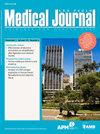“Wake-up” onset of pharyngocervicobrachial variant of Guillain-Barré syndrome: a case report
IF 1.3
4区 医学
Q2 MEDICINE, GENERAL & INTERNAL
引用次数: 0
Abstract
Guillain-Barré syndrome (GBS) is the most common cause of acute flaccid paralysis in the world. There are variants. Of the cranial forms, the following stand out: the classic form, facial diplegia with distal paresthesias, pharyngo-cervico-brachial form, polyneuritis cranialis, Miller-Fisher syndrome and Bickerstaff encephalitis. This study aimed to report the case of a 73-year-old male patient, diabetic, former smoker and alcoholic, who presented at the Neurology outpatient clinic of a tertiary hospital in Pernambuco, after emergency care and 19 days of symptoms, reported as sudden cervical weakness, dysarthrophonia, dysphagia and weakness in the right hemiface, three weeks after vaccination (influenza and triple viral) and flu syndrome. He had dyspnea since the onset of the condition, with no progression or fluctuating complaints. The neurological examination showed multiple cranial nerve syndrome (right peripheral pattern facial palsy, reduced elevation of the soft palate and cervical extension paresis) associated with global hypo/arreflexia. Complementary exams showed, in addition to leukocytosis and signs of bronchopathy on chest tomography, cerebrospinal fluid with 00 cells and 48 proteins and electroneuromyography with predominantly sensitive axonal polyneuropathy, decrease in bilateral facial motor amplitude, needle with myopathic pattern. Brain magnetic resonance imaging without alterations. With the possibility of cranial polyradiculoneuritis and a history of dyspnea raised, he was admitted to the intensive care unit to monitor his breathing pattern and dysautonomia. He received antibiotic therapy for seven days due to pneumonia and pulse therapy with IVIG (2 g/kg for five days). He maintained progressive improvement of symptoms. He was discharged with a multidisciplinary outpatient follow-up scheduled. It is concluded, therefore, that the recognition of GBS and variant forms is necessary.格林-巴- 综合征咽喉颈臂变异型的“唤醒性”发病1例
吉兰-巴罗综合征(GBS)是世界上最常见的急性弛缓性麻痹病因。有不同的变体。在颅型中,有以下几种比较突出:经典型、面瘫伴远端感觉异常、咽颈臂型、颅多神经炎、米勒-费雪综合征和比克斯塔夫脑炎。本研究旨在报告一名73岁男性患者,糖尿病患者,前吸烟者和酗酒者,他在伯南布哥一家三级医院的神经病学门诊就诊,经过紧急护理和19天的症状,报告为突然颈椎无力,关节障碍,吞咽困难和右半面无力,接种疫苗(流感和三病毒)和流感综合征三周后。他自发病以来就有呼吸困难,无进展或波动性主诉。神经学检查显示多发性颅神经综合征(右外周型面神经麻痹、软腭抬高降低和颈部伸展性轻瘫)与全身反射不足/反射不足有关。补充检查显示,除了白细胞增多和胸部断层扫描支气管病变的征象外,脑脊液有00个细胞和48个蛋白,神经肌电图以敏感轴突多神经病变为主,双侧面部运动幅度下降,针状肌病型。无改变的脑磁共振成像。随着颅多根神经炎的可能性和呼吸困难史的增加,他被送进重症监护病房监测他的呼吸模式和自主神经异常。患者因肺炎接受了7天的抗生素治疗和5天的IVIG脉冲治疗(2g /kg)。他的症状持续改善。出院时安排了多学科门诊随访。因此,有必要对GBS及其变体形式进行识别。
本文章由计算机程序翻译,如有差异,请以英文原文为准。
求助全文
约1分钟内获得全文
求助全文
来源期刊

Sao Paulo Medical Journal
医学-医学:内科
CiteScore
2.20
自引率
7.10%
发文量
210
审稿时长
6-12 weeks
期刊介绍:
Published bimonthly by the Associação Paulista de Medicina, the journal accepts articles in the fields of clinical health science (internal medicine, gynecology and obstetrics, mental health, surgery, pediatrics and public health). Articles will be accepted in the form of original articles (clinical trials, cohort, case-control, prevalence, incidence, accuracy and cost-effectiveness studies and systematic reviews with or without meta-analysis), narrative reviews of the literature, case reports, short communications and letters to the editor. Papers with a commercial objective will not be accepted.
 求助内容:
求助内容: 应助结果提醒方式:
应助结果提醒方式:


